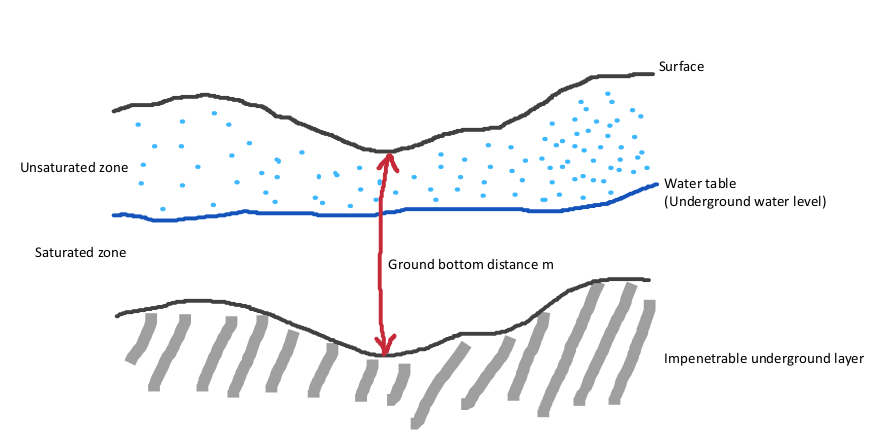Ground model (Water Overlay): Difference between revisions
| Line 25: | Line 25: | ||
===Horizontal flow and aquifers=== | ===Horizontal flow and aquifers=== | ||
[[File:Undergroundflow.png|right]] | [[File:Undergroundflow.png|right]] | ||
Underground flow is different from surface flow, since it has to account for the slowdown and porousness of the medium. In general, horizontal underground flow is calculated using formulas described in Harbaugh 2005<ref name="Harbaugh"/><ref name="Modflow"/>. However, when an [[Hydraulic features (Water Overlay)#Aquifer|aquifer]] is present, the aquifer variant is applied. | Underground flow is different from surface flow, since it has to account for the slowdown and porousness of the medium. In general, horizontal underground flow is calculated using formulas described in Harbaugh 2005<ref name="Harbaugh"/><ref name="Modflow"/>. However, when an [[Hydraulic features (Water Overlay)#Aquifer|aquifer]] is present, the horizontal aquifer flow variant is applied. | ||
Both formulas are described [[Underground_flow_formula_(Water_Overlay)|here]].<br style="clear:both"> | Both formulas are described [[Underground_flow_formula_(Water_Overlay)|here]].<br style="clear:both"> | ||
Revision as of 14:37, 25 April 2019
The Water Module also contains a simplified 2-layer underground model, for infiltration, evaporation and horizontal flow in the underground. Additionally, the model also applies a simplified form of exfiltration of water from the soil back onto the surface layer.
Activation
Only groundwater overlays activate the underground model by default. If the underground model is not active, water can not infiltrate, exfiltrate, evaporate or flow in/from the underground. Other water overlays can activate the underground model by adjusting the value of the GROUND_WATER attribute to 1.
Two Layered model
The assumption is made that underground is bound vertically by the surface of the terrain at the top and by an impenetrable layer at the bottom. The distance between the surface and the impenetrable layer, and thus the effective height of the underground, is equal to GROUND_BOTTOM_DISTANCE_M. In other words, the impenetrable underground layer is assumed to be a set distance below the surface. The distance is uniform across the entire project area, and therefore follows the profile of the surface.
The fraction of water the underground can store per volume is defined with the WATER_STORAGE_PERCENTAGE attribute of the underground layer terrain.
Furthermore, the underground is composed of 2 layers: the unsaturated zone and the saturated zone. The saturated zone is the region of the underground where the soil is fully saturated with water. The unsaturated zone is the region of the underground located directly above the saturated zone. This region can also contain water, but the amount contained is always less than the maximum storage fraction.
The edge between the unsaturated and saturated zone is defined as the groundwater level.
The groundwater table is the datum height of the top of the saturated zone. The amount of water in the saturated zone is determined with the datum height of the groundwater table, the datum height of the surface, the GROUND_BOTTOM_DISTANCE_M and the underground terrain's WATER_STORAGE_PERCENTAGE.
Initialization
The underground water level is initialized with the values of the ground water GeoTIFF connected to the water model. If no ground water data is connected, the ground water level relative to datum is equal to the surface water level relative to datum, as defined by the WATER_LEVEL attribute of the water level area in that location.
Vertical flow
Vertical underground water flow is modeled as infiltration and described in the subsequent model.
Horizontal flow and aquifers
Underground flow is different from surface flow, since it has to account for the slowdown and porousness of the medium. In general, horizontal underground flow is calculated using formulas described in Harbaugh 2005[1][2]. However, when an aquifer is present, the horizontal aquifer flow variant is applied.
Both formulas are described here.
References
- ↑ Harbaugh, A.W., 2005, MODFLOW-2005, the U.S. Geological Survey modular ground-water model-the Ground-Water Flow Process: U.S. Geological Survey Techniques and Methods 6-A16, variously paginated.
- ↑ Langevin, C.D., Hughes, J.D., Banta, E.R., Niswonger, R.G., Panday, Sorab, and Provost, A.M. (2017) ∙ Documentation for the MODFLOW 6 Groundwater Flow Model: U.S. Geological Survey Techniques and Methods, book 6, chap. A55 ∙ p 31 ∙ found at: https://doi.org/10.3133/tm6A55 (last visited 2019-02-04)

